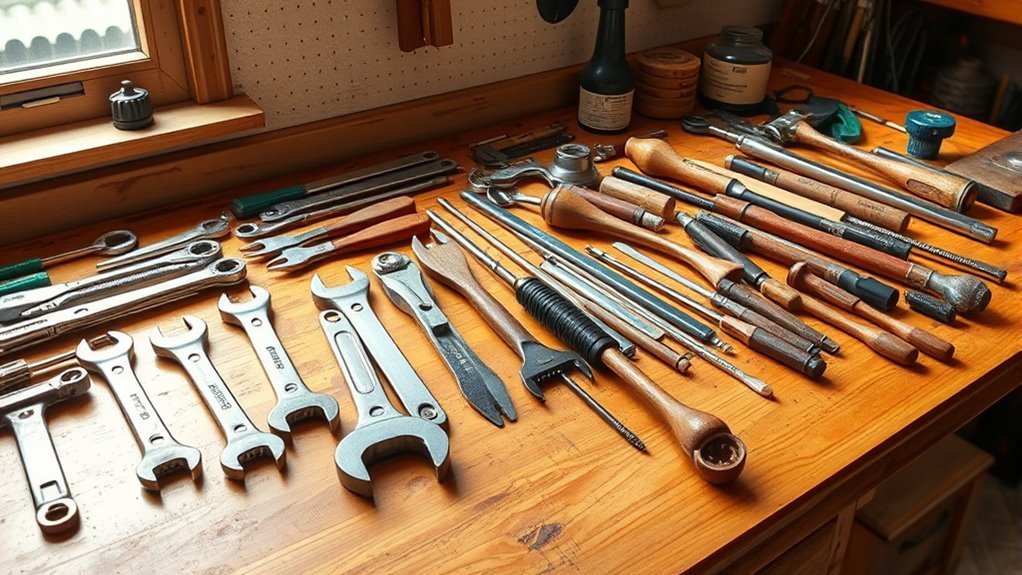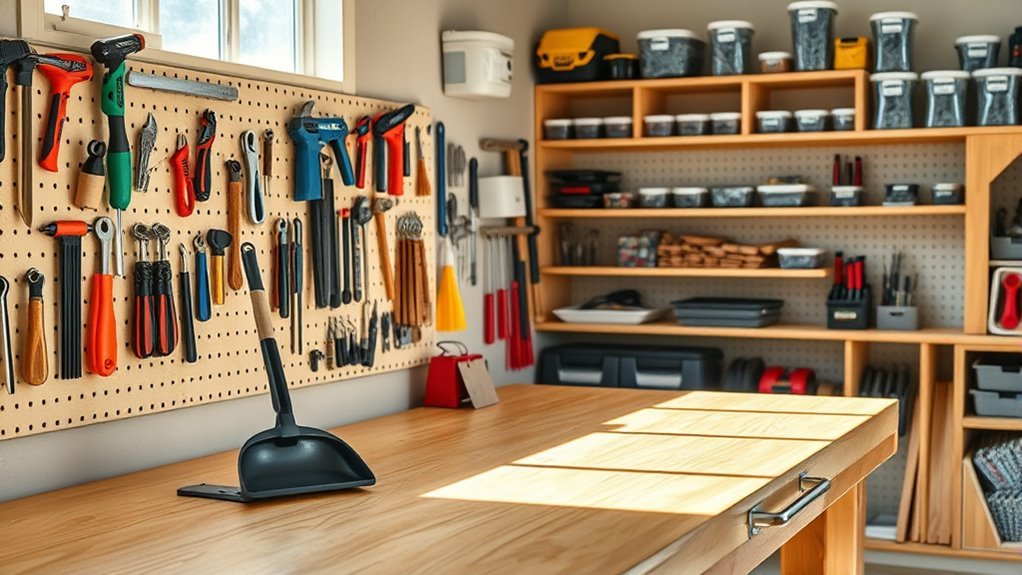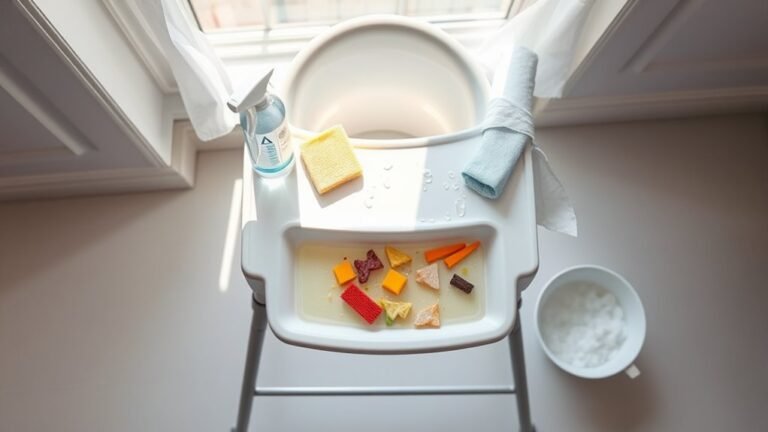Cleaning Your Home Workshop: Tools and Surfaces
To keep your home workshop clean, use durable microfiber cloths, a sturdy broom, and a handheld vacuum to remove sawdust and debris from surfaces and floors. Wipe down hand tools to prevent rust and oil metal parts regularly. For power tools, clear dust from vents and lubricate moving parts. Quickly address grease or oil stains with appropriate cleaners to protect surfaces. Organizing your workspace helps maintain safety and efficiency. There’s more to discover about creating a tidy, productive workshop environment.
Essential Cleaning Supplies for Your Workshop

When it comes to cleaning your workshop, having the right supplies makes all the difference. You want tools that support your freedom to create without clutter slowing you down. Start with durable microfiber cloths and all-purpose cleaners for quick wipe-downs. A sturdy broom and dustpan keep your floors clear, while a handheld vacuum tackles tight spots. Don’t forget storage bins and labels to maintain workshop organization—keeping everything in its place saves time and stress. Establishing consistent cleaning schedules guarantees your space stays functional and inviting, preventing mess from piling up. By choosing essential supplies that fit your workflow, you maintain control and freedom in your creative space, making cleanup less of a chore and more of a routine part of your craft.
Removing Sawdust and Debris From Work Surfaces
Keeping your workshop organized with the right cleaning supplies sets the stage for tackling sawdust and debris on your work surfaces. To maintain freedom in your workspace, focus on efficient sawdust collection methods like using a handheld vacuum or a soft brush to sweep away particles without scratching your surfaces. Don’t forget to protect your worktops with mats or cloths that shield against damage while you clean. Regularly clearing off sawdust not only keeps your workspace neat but also guarantees your projects aren’t compromised by debris. By combining effective sawdust collection with surface protection, you create a clean, safe environment that lets you focus on your craft without distractions or hazards. This approach keeps your workshop ready and free, so you can dive right into your next project.
Cleaning and Maintaining Hand Tools

Extend the life of your hand tools by cleaning and maintaining them regularly. This prevents tool rust and guarantees smooth operation. Wipe down tools after use, oil metal parts, and store them properly to avoid damage. Tool organization plays a key role—keeping everything in its place boosts efficiency and protects your gear.
| Task | Tip |
|---|---|
| Cleaning | Use a wire brush for rust spots |
| Oiling | Apply light machine oil |
| Sharpening | Keep blades sharp for safety |
| Storage | Use pegboards or tool chests |
| Inspection | Check for damage before storing |
Proper Care for Power Tools
You’ll want to keep your power tools free of dust to guarantee they run smoothly. Regular lubrication and maintenance are key to extending their lifespan. Plus, storing them safely will protect both the tools and your workspace.
Regular Dust Removal
Although power tools are built to handle tough jobs, dust buildup can quickly impair their performance and lifespan. You want to keep dust accumulation in check to guarantee your tools run smoothly and last longer. Regularly removing dust not only protects your equipment but also improves the air quality in your workshop, making your space healthier and more enjoyable. Use compressed air or a soft brush to clear dust from vents, motors, and crevices. Doing this after each project prevents grime from settling and keeps your tools ready for action. By staying on top of dust removal, you maintain freedom in your workspace—tools that perform reliably, and air that’s clean and safe. It’s a small effort that makes a big difference in your shop’s efficiency and your peace of mind.
Lubrication and Maintenance
Keeping your power tools running smoothly requires more than just dust removal—it also means regular lubrication and maintenance. Sticking to proper lubrication techniques and following maintenance schedules will extend your tools’ life and keep your freedom to create unhindered.
Here’s how you can care for your power tools effectively:
- Identify moving parts that need lubrication.
- Use manufacturer-recommended lubricants.
- Apply lubrication sparingly to avoid buildup.
- Set up a clear maintenance schedule based on usage.
- Inspect tools regularly for wear and tear.
Safe Storage Practices
Since power tools can be damaged by moisture, dust, or accidental knocks, storing them properly is crucial to maintain their functionality and safety. You want to create a space where your tools are easily accessible yet protected. Use wall-mounted racks or sturdy cabinets for safe tool storage, keeping everything organized and off the floor. Make certain your power tools are clean and dry before storing them to prevent rust or electrical issues. Remember, batteries and lubricants may require special containers to avoid leaks or spills. When it comes to hazardous material disposal, don’t just toss old oils or solvents in the trash—follow local regulations to dispose of them safely. Taking these steps guarantees your tools stay ready for action while keeping your workshop safe and free.
Dealing With Grease, Oil, and Stains
You’ll often find grease and oil buildup on your workbench and tools, which can be tough to remove if left untreated. Knowing the right stain treatment techniques will help you keep your workshop clean and safe. Let’s explore simple methods to tackle these stubborn marks effectively.
Removing Grease Buildup
Although grease and oil stains are common in workshops, they don’t have to become permanent marks. You’ve got the freedom to keep your space spotless by using effective grease solvents and smart degreasing techniques. Start by tackling buildup before it sets in. Here’s how you can take control:
- Choose a grease solvent suited for your surface—natural or chemical-based.
- Apply degreasing techniques like scrubbing with a stiff brush or soaking rags.
- Use warm water to loosen stubborn grease.
- Wear gloves to protect your skin while cleaning.
- Wipe down tools and benches regularly to prevent buildup.
With these steps, your workshop stays clean, efficient, and ready for your next project. Don’t let grease hold you back.
Stain Treatment Techniques
Keeping grease and oil at bay is only part of the battle; knowing how to treat stains when they happen makes a big difference in maintaining your workshop’s cleanliness. For effective stain removal, addressing spills quickly is key. When dealing with fabric treatment, pre-treat the area with a stain remover or mild detergent before washing. For hard surfaces, use degreasers or vinegar solutions.
| Stain Type | Recommended Treatment |
|---|---|
| Grease | Dish soap + warm water |
| Oil | Baking soda + degreaser |
| Ink | Rubbing alcohol |
| Paint | Mineral spirits or soap |
Organizing Your Workshop for Easier Cleaning

Since clutter can quickly turn a tidy workshop into a chaotic mess, organizing your tools and materials is essential for easier cleaning. A smart workspace layout and efficient tool organization let you move freely and clean swiftly. To get started, consider these steps:
- Designate specific storage spots for each tool.
- Use pegboards or magnetic strips to keep frequently used items visible.
- Group similar materials together to reduce searching time.
- Keep work surfaces clear by storing away tools immediately after use.
- Create labeled bins or drawers to maintain order and speed up cleaning.
Tips for Regular Workshop Maintenance
Even if you stay organized, regular maintenance is key to preventing buildup and ensuring your workshop stays functional. Set a weekly routine to quickly sweep floors and wipe down surfaces to keep dust and debris from accumulating. Regularly inspect your tool inventory—clean and oil tools as needed to extend their life and keep them ready for action. This habit not only saves time but also boosts workshop safety by reducing hazards like rusted blades or cluttered walkways. Don’t forget to check storage areas for spills or worn containers, as these can create unsafe conditions. By staying on top of these simple tasks, you maintain a workspace that supports your freedom to create without interruptions or risks. Keep it clean, safe, and ready to fuel your next project.
Frequently Asked Questions
How Often Should I Deep Clean My Home Workshop?
You don’t want your workshop looking like a tornado hit it, right? To keep your creative freedom flowing, stick to a solid cleaning schedule—deep clean every 1-2 months. This keeps your tools sharp and your workspace inviting. Good workshop organization means less time hunting for stuff and more time making things. Treat your space like your freedom zone—clean it regularly, so clutter doesn’t chain you down.
What Are the Best Eco-Friendly Cleaning Products for Workshops?
If you want to keep your workspace fresh without harming the planet, you’ll love using natural cleaners. They’re tough on grime but gentle on the environment. Look for biodegradable options that break down easily and won’t leave harmful residues. Vinegar, baking soda, and lemon juice are great DIY choices, too. These eco-friendly products give you the freedom to clean confidently, knowing you’re protecting both your workshop and the world outside.
Can I Use Compressed Air for Cleaning Electronics in My Workshop?
You can definitely use compressed air to clean electronic devices, but be careful with the pressure—it’s easy to damage delicate parts if it’s too strong. Hold the can upright to avoid spraying liquid propellant, and keep a safe distance to prevent harm. Compressed air is a great way to free your gadgets from dust without opening them up, giving you a quick, hassle-free way to keep your devices running smoothly.
How Do I Prevent Mold and Mildew in a Damp Workshop?
To prevent mold and mildew in a damp workshop, you’ll want to focus on humidity control first. Use a dehumidifier to keep moisture levels low and avoid that musty smell taking over. Ventilation tips include opening windows or installing exhaust fans to circulate fresh air regularly. Keeping your space dry allows you the freedom to work comfortably without worrying about damage or health risks from mold build-up.
Are There Any Safety Precautions When Cleaning Chemical Spills?
Did you know that over 60% of chemical-related injuries happen because people skip safety steps? When cleaning chemical spills, you’ve got to prioritize spill containment to stop it from spreading. Always wear proper protective equipment like gloves and goggles to keep yourself safe. Quick action and the right gear give you the freedom to clean confidently without risking harm. Stay prepared, and you’ll handle spills like a pro every time.






